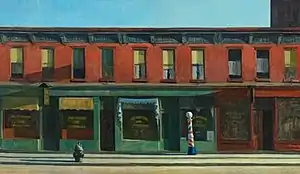Early Sunday Morning
Early Sunday Morning is a 1930 painting by American artist Edward Hopper.
| Early Sunday Morning | |
|---|---|
 | |
| Artist | Edward Hopper |
| Year | 1930 |
| Medium | oil paint, canvas |
| Movement | American scene painting, social realism |
| Dimensions | 89.4 cm (35.2 in) × 153 cm (60 in) |
| Location | United States |
| Collection | Whitney Museum of American Art |
| Accession No. | 31.426 |
Description
The painting portrays the small businesses and shops of Seventh Avenue in New York City shortly after sunrise. It shows a cloudless sky over a long, red building. A red and blue striped barber pole sits in front of one of the doorways on the right side of the sidewalk, and a green fire hydrant is on the left. The bleak, empty street and storefronts are said to be a representation of the dire state of the city during the Great Depression.
Despite the title, Hopper has said that the painting was not necessarily based on a Sunday view. The painting was originally titled Seventh Avenue Shops. The addition of "Sunday" to the title was "tacked on by someone else".[1]
The image was based on a building nearby Hopper's studio. It is said to be "almost a literal translation of Seventh Avenue", however a few minor details were changed, like decreasing the size of the doorways and making less clear the letters on the storefront. [2]
Provenance
It is currently in the collection of the Whitney Museum of American Art.[3][4][5][6]
The piece was originally sold to the Whitney for $2,000.[7] It was purchased with funds from Gertrude Vanderbilt Whitney just a few months after it was painted, and would go on to become a part of the Whitney's founding collection. [8]
Critical response
"Early Sunday Morning is a prelude to the wakeful coffee urns and to those who tend them to defeat the night". Karal Ann Marling [9]
"The painting’s bone-deep conservatism, and its obvious, almost polemical resistance to the most ambitious European art of its day. In the midst of the depression in America, that conservatism is as much a part of the painting’s subject as the closed shops it depicts." Blake Gopnik [10]
The painting has become the inspiration for other works of art. Examples include Byron Vazakas' poem "Early Sunday Morning" [11] and John Stone's poem of the same name.[12]
References
- Levin, Gail (1995). Edward Hopper: An intimate biography. New York: Knopf.
- Miller, Dana (2015). Whitney Museum of Art: Handbook of the Collection. New Haven and London: Yale University Press. ISBN 9780300211832.
- "Whitney.org". Archived from the original on 2011-06-18. Retrieved 2011-10-17.
- "Edward Hopper: Early Sunday Morning". www.artchive.com.
- "Edward Hopper / Early Sunday Morning / (1930)". www.davidrumsey.com.
- "Gale.cengage.com" (PDF).
- "Hopper: the Supreme American Realist of the 20th Century". www.smithsonianmag.com.
- Miller, Dana (2015). Whitney Museum of Art: Handbook of the Collection. New Haven and London: Yale University Press. ISBN 9780300211832.
- Marling, Karal Ann (1988). "Early Sunday Morning". Smithsonian Studies in American Art. 2 (3): 22-53. doi:10.1086/smitstudamerart.2.3.3108956. S2CID 191620492.
- https://news.artnet.com/exhibitions/whitney-hoppers-sunday-morning-politics-culture-294441
- Vazakas, Bryon (1957). "Early Sunday Morning". The Virginia Quarterly Review. 33 (3): 377.
- Stone, John (1985). "Early Sunday Morning". The American Scholar. 54 (1): 119–120. JSTOR 41211145.